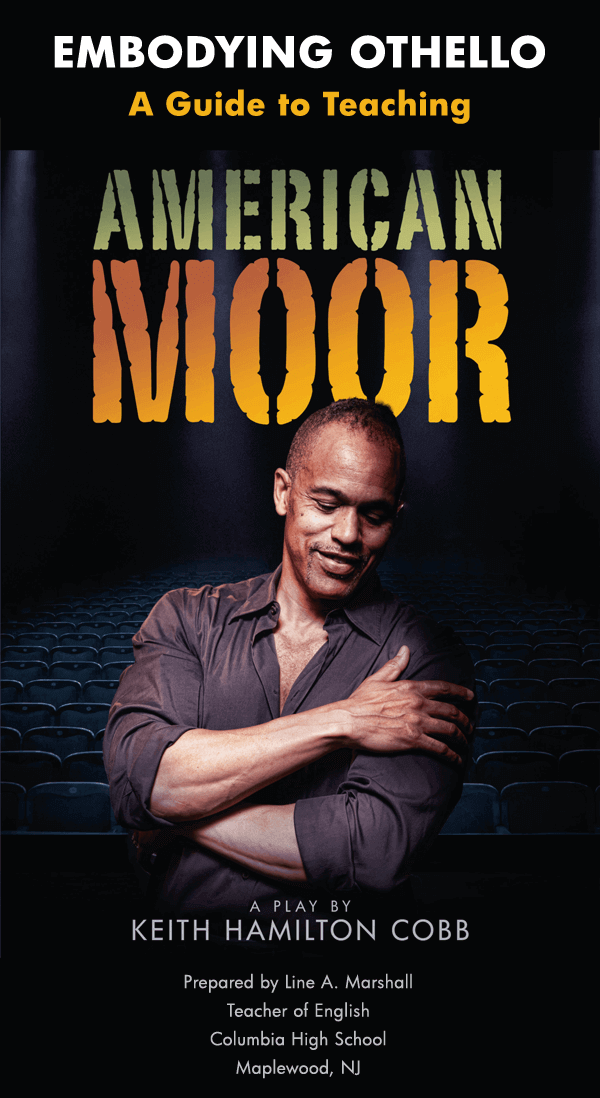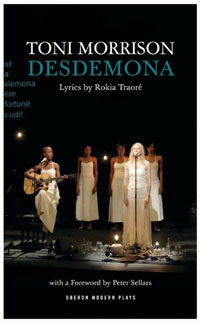#AmericanMoorEducation
Intro
I do not think that I’m an authority on teaching this work in any sense. I share my experience with the hope that other White teachers in White-dominant contexts might be able to benefit from my thoughts and improve on my approach.
Danielle Peck
English Educator
Grosse Pointe South High School, Grosse Pointe Farms, Michigan
Since the publishing of American Moor by Methuen Drama in the spring of 2020, the embrace by educational institutions across the United States has been extremely exciting. It is exciting to consider that the structures of White normativity that the play seeks to expose—so compromising of American culture and American-made art—are finding forums for conversation on the high-school level. On the university level, the play seems to sit at the nexus of several avenues of academic pursuit, be it English, Africana Studies, Theatre Studies, Political Science, Gender Studies, or Critical Race Theory…
Throughout, what educators are discovering is that American Moor, in its unique approach to the issues of endemic American racial bias, seems to sharply reflect practices and behaviors in the lives of those who take it up. That is to say that the dynamics explored in the play are the same dynamics existing in the classrooms, and in the country at large. Consequently, though teachers are finding a greater value in tackling the work than in avoiding it, the effort comes with challenges that are as new, and often troubling as the play itself.
In the months since the first educators began to add American Moor to their curriculums, several have responded with frank and revealing expressions of their experiences, both on a personal level as well as in class. It is my hope that I can build a forum on this page to not only present some of this documentation that may serve as material to help guide others in their work around this play, but also to serve as a place of engagement among academics who have honored me with the taking of this difficult work into their classrooms.
Though you will find references to further related reading within some of the documents offered, I will also feature pieces of other writers as I discover them, or they occur to me, that focus around the questions arising in the play. My further hope is that others will take from this page what assists them in furthering their own efforts in engaging what, if it is to create any significant change, can never be a foreshortened discussion, and that they will also share their experiences with this work as a learning tool for colleagues.
– Keith Hamilton Cobb
Speaking on Shakespeare
“Why Not This Actor?”
Not “Why this actor?” but “Why not this actor?”
Newton South High School
Speak of Me as I AM…
Othello 202: American Moor
Mary Baldwin College
Further Reading
I expect the list below to grow as educators interact with the page, and perhaps offer their own suggestions. Please feel free to contact me with thoughts and reflections as well as suggestions of your own.
Read Notes
This appropriation is an important look at the pivotal characters that people the world of Othello through the creative lens of an iconic African American novelist. As such it offers possible insight into character motivations and back stories that we cannot expect from Shakespeare, or from his self-appointed acolytes.
Read Notes
It can be a reach to follow the Othello allusions in this beautiful novel by a Sudanese author about the impact of British Colonialism on African society. They are most clear when the narrator of the story discusses his relationship with himself as influenced by, and to some extent through, the women in British society with whom he has relationships. This has less bearing perhaps on American Moor than on the imagining and crafting of the psychology of Othello, the man. Then again, American Moor has a great deal to do with one being afforded the freedom to do precisely that…
amazon.com/Season-Migration-North-Review-Classics/dp/1590173023
Read Notes
Particular focus in this iconic work should be given to Du Bois as he expounds on the idea and the condition of Double Consciousness which echoes loudly in the protagonist’s musings and behaviors in American Moor.
Read Notes
This is a difficult one to find, because it was published from a talk that the author, Hugh Quarshie, a Ghanaian British actor, gave in 1998 at the University of Alabama. He speaks with great depth of thought for and against attempting to tackle the role as an African descended actor, mostly against. This is most interesting in light of the fact that he did ultimately take on the roll in a 2015 RSC production directed by Iqbal Kahn. His disquisition in this paper influenced a great deal of the thinking that contributed to the creation of American Moor. It seems to me it should be available as a PDF online somewhere. Here is a good place to begin to look:
worldcat.org/title/second-thoughts-about-othello/oclc/54505364
Read Notes
Wincing at Shakespeare: Looking B(l)ack at the Bard
Published online by Cambridge University Press: 09 December 2019
AMBEREEN DADABHOY
Abstract
Hamilton Cobb in American Moor interrogates Shakespeare’s presentation of black identity. In particular, I suggest that modes of ambivalence undergird black American engagement with Shakespeare and that this ambivalence creates the space for black artists to interrogate Shakespeare’s representation of blackness and white culture’s gatekeeping of the Shakespearean text and its performance while also reimagining and recasting that representation to fit their contemporaneous needs.
This piece of scholarship is in an online publication of Cambridge University Press, so there is a pay wall to access the article. It is important reading, however, toward understanding the cultural environment wherein American Moor takes life, and perhaps an arrangement can be made by reaching out to the author at dadabhoy@hmc.edu.








